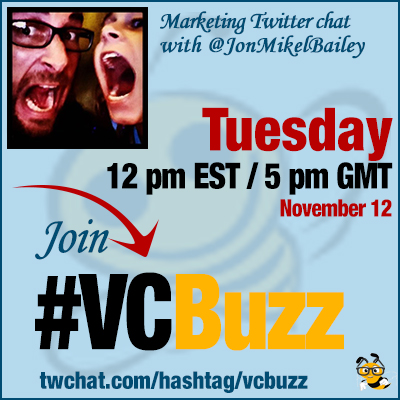
Do you wonder what vendors think about your Website Redesign RFP? Chances are, it’s not good.
Let’s take this time to discuss what makes a good project narrative, why specs are crucial, how to determine realistic goals and timelines, and why you must be open about budget.
***Add #VCBuzz chats to your calendar here.
***Please sign in here to follow the chat -> twchat.com/hashtag/vcbuzz
About Jon-Mikel Bailey
Jon-Mikel Bailey is the Chief Development and Marketing Officer for Wellspring Search, a full-service digital marketing firm specializing in SEO, PPC, Marketing Automation, and Content Marketing.
He has been published in MarketingProfs, Business2Community, SpinSucks, {Grow}, Social Media Today, and more. He has spoken at the Digital Summit Series, MarketingProfs, ITE, Grant Thornton, and others.
He has a BFA in Fine Art in Photography from Frostburg State University and still shoots photos for Wood Street clients.
Questions we discussed
Q1 How did you become a digital marketer? Please share your career story!
Well, in first grade I used to tell people I would own an ad agency one day. I wasn’t too far off, but it took a while to get there.
wow that’s an unusual dream to have for a kid! Looks like you know what you want! #vcbuzz
— Hire Bloggers (@hireblogger) December 10, 2019
I owned a company building waterfalls and watergardens out of college. Then, my body said, “nope, you ain’t got the back for this.” So, after a few different sales jobs, I ended up with a position as the Director of Client Services for a web design firm.
When that company suffered a hit after 9/11 my buddy Jamie Stup (who worked with me) started Wood Street, a web design and development firm. It’s been 17 years! The name comes from where Jamie and I shared a house in college on Wood Street in Frostburg, MD.
It depends on your skillset. Focus on what you do well and partner on the rest.
— Jon-Mikel Bailey (@JonMikelBailey) December 10, 2019
Q2: What are the elements of an effective project narrative/scope?
A well-written scope of work should always be written with the end-user in mind. Your corporate history or mission needs to take a back seat. Make this all about what the user needs and how the website will meet those needs.
It should contain a Simple Project Narrative, Straightforward Project Specs as they relate user needs.
a2 Elements in Initial Client Web Work:
— Debi Norton (@BRAVOMedia1) December 10, 2019
⚡What are the Business Goals
⚡Who is the Target Audience
⚡What R U Currently Doing Online (baseline/audit)
⚡What Do You Want Visitors “to-do” online, ie form fillin phone calls buy?
⚡Budget#VCBuzz
Also should contain Agreed Upon and Measurable Goals that are attainable, Realistic Timelines and Milestones, A Real and Realistic Budget.
Remember, good web design agencies are busy; make your RFP and scope of work easy for them!! A perfect scope of work should require no questions from the vendor. Make that your goal!
Are there good templates you could pint us out to? #vcbuzz
— Social Media Sun (@sun_social) December 10, 2019
Not really, and I looked. I’ve outlined the process here.
Q3: How detailed do you need to get with functionality needs, technical specs, and project goals?
The project specs should be clear enough that the web design firm knows exactly what you want them to design and build.
If you’re not technical, no worries, just focus on how it needs to work in your own words. It should read almost like a story, the user story.
If you give examples, make sure they are from websites with similar budgets, teams, etc. In other words, if you tell me you want to build the Uber of Dog Walking and your budget is 20k, we have a disconnect.
Being as detailed as possible while focusing on the user experience will allow you to go back through and prioritize.
Ask yourself while you review your specs, which items are essential for launch? This will get you live faster so you can test and make improvements based on real user needs. Keep it real!
And if you’re not technical, it may be helpful to get someone who is to read your scope. They can help you backfill in information like coding language, development framework, and required hosting environment.
The vendors will ask for this technical information anyway, so do what you can to get it in your scope upfront.
I have been burned before when I first started as a freelancer and now know the importance of contracts and a deposit. I find some potential clients are put off by contracts and deposits. Any advice to counteract that @JonMikelBailey #vcbuzz https://t.co/o7rSQvnPem
— Phillip ??? (@PhilldotBlog) December 10, 2019
Outline and document everything. Make sure everyone agrees on the scope, money, and timeline. That doc is your safeguard if things go off the rails. Clients put off by contracts and deposits make me very nervous. We won’t work with anyone without a contract of some sort.
a3 When Discussing Web work w/ a client, meet them where they are at. Speak their language while being cognizant to understand the online functionality they need & can afford. #VCBuzz
— Debi Norton (@BRAVOMedia1) December 10, 2019
Q4: Does your timeline need to be firm? What about budget? How can these things make or break an RFP?
If you have a firm deadline, you should have a compelling reason as to why it is firm. Otherwise, you’re just picking an arbitrary deadline which helps no one.
As discussed in A3, identify the minimum viable website you need at launch. Then, what factors will support its success from a timeline perspective?
Your timeline should be attainable. If you impose an impossible deadline, be wary of the firms who say “yeah, sure, no problem.” I don’t know about you, but I prefer it when things go as planned as opposed to planning for failure.
Also, if your timeline is super aggressive, busy agencies won’t even bother bidding on your project. So, you could end up with a bunch of desperate vendors bidding on your project. In this case, it’s doubtful you will be pleased with the results.
A good timeline should time for: meetings, schedules, and availability; discovery and planning; design and review; development and review; testing and testing, and more testing.
The more honest you are about your deadline and your budget, the better off you’ll be. You’ll get honest bids from reputable agencies who deliver on what they promise. If a bid seems too good to be true… it is.
Q5: Is an RFP necessary? What are the alternatives?
Some organizations have to write and distribute RFPs. I get it. If you must, then make it a good, detailed, and honest RFP. If you don’t need to do an RFP, consider yourself lucky.
Web design is a conversation. Meet with agencies before the RFP, tell them your goals and get feedback. Ask them if they would respond, and if not, why not? Ask for price ranges based on your goals. An upfront conversation will lead to a stellar website.
a5 RFP’s (unless there is prior relationship) – are like job interviews. You’re have to “bid” & give”time/costs” on client’s project scope. #VCBuzz
— Debi Norton (@BRAVOMedia1) December 10, 2019
In my experience, it is much better for everyone if you can search for a handful of agencies and then have discussions with them based on your scope of work.
Interview a handful of reputable agencies, check references, ask tough questions, and then ask the ones you feel good about to bid on your project based on your scope of work. Otherwise, it’s a blind date… awkward.
Remember, the idea is to find the best vendor for the job. A well-written scope is crucial!
Q6: What are some of the worst things you’ve seen on an RFP?
My favorite is the use of the word “etc.” How do you bid on ETC????
Another fun one is asking for a 50k website in two months. I’m not sure where people are getting the info about web design timelines, but I guarantee that for some it isn’t from web design agencies.
A6: We once received one for digital advertising that had an entire series that was lifted directly from a construction project RFP – material type, supply number, etc. – and applied to FB/Programmatic ad buy structures #VCBuzz
— Sam Ruchlewicz (@SamRuchlewicz) December 10, 2019
EXACTLY!!! I’ve received ones where the contact listed is someone who no longer works there!
The absolute worst is when we get an RFP with 20 pages of company fluff and boilerplate and two pages (usually at the end of the RFP) of information about the project.
Remember, the agencies are wary of RFPs because of the lost percentage. If they think you’re not serious, then they most likely will not bid.
Our previous web design chats:
- Starting and Managing a Successful Niche News Website w/ Barry Schwartz @rustybrick #VCBuzz
- How to Set up Fully Functioning, Living and Breathing Affiliate eCommerce Website with Patrick Coombe @pmkoom #VCBuzz
- How to Improve Your Site Structure? with Bobby Kircher @bobbykircher #VCBuzz
- SEO Migrations: Tips and Steps with @Renee_Girard #vcbuzz



